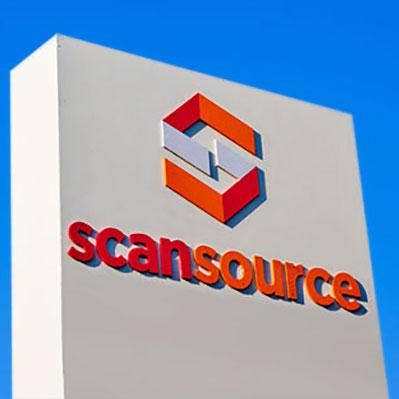ScanSource President: Combining Digital, Hardware Distribution Key To Success
‘Hybrid distribution for us is really all about enabling customer choice. And it‘s really all about, as we talked about before, connecting devices in the cloud and selling devices plus digital. Think of it as ‘hardware-plus.’ More hardware plus more cloud plus more services,’ says ScanSource President John Eldh.

John Eldh
Building On Growth
IT distributor ScanSource this week reported a 10.1-percent year-over-year rise in sales to $943.8 million and an 8.9-percent rise in GAAP net income to $24 million in its most recent quarter .
All in all, it was a great quarter for the distributor, said John Eldh, president of the Greenville, S.C.-based company. Eldh, who in February took over as ScanSource’s president after driving the firm’s hybrid distribution strategy, told CRN in an exclusive post-earnings meeting that the key for future growth is the strategy of combining the company’s mobility and related digital products and services into complete solutions for its channel partners.
ScanSource’s digital business is growing faster than its hardware business, but the hardware business is still a much larger part of the distributor’s revenue, making them both important going forward, Eldh said.
[Related: ScanSource Gets New President, Reports Q2 Growth: 5 Things To Know]
“From a revenue perspective, and from its importance to our gross profit, importance for the company, hardware is extremely important to us in terms of our profitability and our growth,” he said. “But we see the digital part of our business growing faster this quarter. And in the last few quarters, we’ve seen our hardware growth be very, very strong, and even challenge that digital growth in some periods. But overall longer term, we think digital will continue to grow faster.”
ScanSource’s hybrid distribution strategy is also important to the distributor’s channel partners, Eldh said.
“[Hybrid distribution’ has expanded their market opportunity and helped them drive differentiated growth and helped them move into recurring revenue,” he said. “And maybe most importantly, helped them to say ‘yes’ to customer requirements because they now have a one-stop shop in ScanSource where they can come for all the components that make up the solution.”
There’s a lot going on at ScanSource that is not reflected in a simple quarterly financial report. For details, read on.

How did the first fiscal quarter of 2023 look for ScanSource?
We had a great earnings call. We’re very excited about our results. And I think the headline maybe you heard [ScanSource Chairman and CEO] Mike [Baur] talk about at the beginning was our transformation as a company, putting us in a position being the leader in hybrid distribution, and how our acquisition of Intelisys has really paved the way to put us in a position to be leading this world of connecting devices to the cloud. And that ultimately has helped us to deliver what you would have heard was really strong results of 10 percent top line growth. We’ve now achieved double-digit growth five out of the last six quarters. That’s really, really strong. We saw continuing strength in demand out in the market. Our relationships continue to get stronger with our customers and suppliers, helping us to drive market growth.
What’s behind the growth? What’s pushing those sales?
We play in all large and growing markets. And there‘s strong demand in each of these markets. The key segments that we’re playing in are all very strong whether it‘s automation, worker productivity, and mobility. These are all about deploying mission-critical devices. They’re not nice-to-haves. They’re need-to-haves. Whether it’s in those areas, or physical security, which you know is always a strong segment, or point of sale and payment, we‘re playing in all of those markets. And we’re leading in all those markets. And I think, really, the whole capabilities around hybrid distribution really added to our success being able to help customers with true solutions that include both hardware and software so that they can deliver for their end customer requirements.
You just used the term hybrid distribution. Can you explain what you mean by that?
Hybrid distribution for us is really all about enabling customer choice. And it‘s really all about, as we talked about before, connecting devices in the cloud and selling devices plus digital. Think of it as ‘hardware-plus.’ More hardware plus more cloud plus more services.

Based on your definition of hybrid distribution, how big a part is that of ScanSource’s total revenue?
When we report the digital business, in terms of our top line, it‘s not as impactful of a number. But when you drop down to gross profit, that’s where it becomes meaningful to us when you‘re looking at our reported numbers. So 24 percent of our total gross profit for the company consolidated is recurring and coming out of those digital hybrid streams. The rest of it, the 76 percent, would be coming out of the device and single point services that happen. So to us that’s meaningful. That validates our hybrid distribution strategy from a financial perspective. So once we get to kind of that 24, 25-percent point, we feel like now it‘s meaningful and it validates that we’re on the right path from a strategy perspective.
Which part of the business is growing faster?
The digital part grows faster than the hardware for sure. That‘s not unusual. But we have a huge hardware base. And so from a revenue perspective, and from its importance to our gross profit, importance for the company, hardware is extremely important to us in terms of our profitability and our growth. But we see the digital part of our business growing faster this quarter. And in the last few quarters, we’ve seen our hardware growth be very, very strong, and even challenge that digital growth in some periods. But overall longer term, we think digital will continue to grow faster.
So what does that growth in the digital business mean for ScanSource’s channel partners?
You may have heard about our ScanSource Channel Connect conference, which was our largest in-person event ever, hosted last month in Nashville, Tennessee. We had just under 2,000 partners and suppliers there. And it was just an incredible event. And when I think about what hybrid has meant to partners, it has expanded their market opportunity and helped them drive differentiated growth and helped them move into recurring revenue. And maybe most importantly, helped them to say ‘yes’ to customer requirements because they now have a one-stop shop in ScanSource where they can come for all the components that make up the solution.
Looking forward, what are your expectations on the digital side of the business, not only in terms of sales but maybe some changes or additions you want to make going into 2023?
We introduced some mid-range goals in our investor deck in our last call. And I think that really kind of speaks to where we think that digital is going. So we believe it will be 30 percent-plus of our gross project will be coming from recurring revenue digital streams in the next three to four years. That‘s on an organic basis. And so we think this continues to grow faster than the hardware and continues to expand our margins and should deliver a great ROIC (return on invested capital) for us as we go forward.

How about in terms of the technology side? What are some things that ScanSource wants to do to bulk up that business going into next year?
Well, I think it comes around capabilities. When we think about how can we better serve our customers and our channel partners, it comes down to capabilities and finding those capabilities where we can scale and be more of a channel partner for them than a point partner going forward. So when we talk about acquisition opportunities for the company, it would be a couple of things. It would be things that would grow our gross profit margins. Services would definitely do that, solutions services for sure. Or grow more recurring. And so when we think about targets for 2023, or targets for the future, it would be those kinds of capabilities that allow us to make hybrid easy for our partners.
So it sounds like what you just said is that acquisition appears to be a part of your strategy for the digital part of the business. Do you have anything keyed up?
Well, we wouldn’t talk about things that are teed up. But I will tell you that we’ve got an active M&A pipeline of exactly what you’re talking about. When we unpack what kinds of targets we would have in our earnings calls and our investor calls, it would be things that would expand our recurring revenue streams. It would be things that would expand our gross profit margins, or things that would help us grow. Those are the kinds of things that we would look for as acquisition targets.
When was ScanSource’s last acquisition? It‘s been a while, right?
2019, I believe, was the last one that we made, [of cloud services provider intY]. I’ll just say ‘we’re due.’ And we feel like we’ve got the right balance sheet position to be able to do that.
Distribution last year was characterized by a couple of big consolidation moves as Ingram Micro was acquired by Platinum Equity and TD Synnex was born from the merger of Tech Data and Synnex. How did those moves impact ScanSource?
We‘re not seeing a big impact from consolidation on our business. One reason is that we don’t go head-to-head with those guys on our line card often. And any kind of large acquisitions is tough to pull together. It takes a while. And I know they‘re working through their acquisitions. But we don’t we just don‘t run into them very often in a competitive nature.
Do you see any future consolidation happening in IT distribution?
I think consolidation is good to a point, and then it becomes a case of less choice and less value to our partners and to the suppliers.